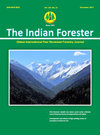Modelling Probable Distribution of Podophyllum hexandrum in North-Western Himalaya
DOI:
https://doi.org/10.36808/if/2017/v143i12/120381Keywords:
GIS, Himalaya, Maxent, Modelling, Niche, Podophyllum.Abstract
Podophyllum hexandrum Royle is a critically endangered plant, which has high demand in pharmaceutical industries. In order to conserve this plant, the suitable regions of its occurrence should be known, which can be targeted for its in-situ natural plantation and phyto-diversity studies. Therefore, a niche modelling was carried out using 'Maxent' to find out probable distribution of P. hexandrum in Himachal Pradesh (HP) of north-western Himalaya. The model output showed that 18.76 % area of HP is suitable for occurrence of P. Hexandrum. Of the total area, 7.91% constitute high and very high probability regions. The Chamba region was identified to possess largest probable area of P. hexandrum. Ecological surveys should be conducted in these regions to find out its current status for formulating plans for its conservation. The plantations of P. hexandrum, if targeted in these identified niches, would not only increase its productivity but will also maintain quality of its chemical produce. The mean temperature of the coldest quarter was observed as one of the important environmental factors responsible for its spatial distribution.References
Alam M.A. and Naik P.K. (2009). Impact of Soil Nutrients and Environmental Factors on Podophyllotoxin Content among 28 Podophyllum hexandrum Populations of North-western Himalayan Region Using Linear and Nonlinear Approaches. Communications in Soil Science and Plant Analysis, 40: 2485–2504.
Alam M.F., Gulati P., Gulati A.K., Mishra G.P. and Naik P.K. (2009). Assessment of genetic diversity among Podophyllum hexandrum genotypes of the North-western Himalayan region for podophyllotoxin production. Indian J. Biotechnology, 8: 391-399.
Babar S., Amarnath G., Reddy C.S., Jentsch A. and Sudhakar S. (2012). Species distribution models: ecological explanation and prediction of an endemic and endangered plant species (Pterocarpus santalinus L. f.). Current Science, 102(8): 1157-1165.
Chakraborty A., Bhattacharya D., Ghanta S. and Chattopadhyay S. (2010). An efficient protocol for in vitro regeneration of Podophyllum hexandrum, a critically endangered medicinal plant. Indian J. Biotechnology, 9: 217-220.
Chaurasia O.P., Ballabh B., Tayade A., Kumar R., Kumar G.P. and Singh S.B. (2012). Podophyllum L: an endangered and anticancerous medicinal plant - an overview. Indian J. Traditional Knowledge, 11(2): 234-241.
Dogra V., Ahuja P.S. and Sreenivasulu Y. (2013). Change in protein content during seed germination of a high altitude plant Podophyllum hexandrum Royle. J. Proteomics, 78: 26-38.
Elith J., Phillips S.J., Hastie T., Dudı´K M., Chee Y.E. and Yates C.J. (2011). A statistical explanation of Maxent for ecologists, Diversity and Distributions. 17: 43–57
Jaryan V., Datta A., Uniyal S.K., Kumar A., Gupta R.C. and Singh R.D. (2013). Modelling potential distribution of Sapium sebiferum– an invasive tree species in western Himalaya. Current Science, 105(9):1282-1288.
Kharkwal A.C., Kushwaha R., Prakash O., Ogra R.K., Bhattacharya A., Nagar P.K. and Ahuja P.S. (2008). An efficient method of propagation of Podophyllum hexandrum: an endangered medicinal plant of the Western Himalayas under ex situ conditions. J. Natural Medicines, 62(2): 211-6.
Kushwaha R., Bhattacharya A., Singh B. and Singh R.D. (2012). Factors affecting podophyllotoxin yield in the ex situ grown Podophyllum hexandrum, an endangered alpine native of the western Himalayas. J. Natural Medicines, 66(1): 1-7.
Kushwaha R., Chanda S., Ogra R.K. and Bhattacharya A. (2010). Cryopreservation Criteria of Podophyllum hexandrum and Aconitum heterophyllum seeds based on storage behavior. Seed Technology, 32(2): 117-127.
Kushwaha R., Pandey S., Chanda S., Bhattacharya A. and Ahuja P.S. (2008). Temperature dependent growth and emergence of functional leaves: An adaptive mechanism in the seedlings of the western Himalayan plant Podophyllum hexandrum. J. Plant Research, 121: 299-309.
Loetter D. and Le-Maitre D. (2014). Modelling the distribution of Aspalathus linearis (Rooibos tea): implications of climate change for livelihoods dependent on both cultivation and harvesting from the wild. Ecology and Evolution, 4(8): 1209-1221.
Man R.S. and Samant S.S. (2011). Diversity, indigenous uses and conservation status of medicinal plants in Manali wildlife sanctuary, North Western Himalaya. Indian J. Traditional Knowledge, 10(3): 439-459.
Maqbool M. (2011). Mayapple: A review of the literature from a horticultural perspective. J. Medicinal Plants Research, 5(7): 1037-1045.
Nadeem M., Palni L.M.S., Purohit A.N., Pandey H. and Nandi S.K. (2000). Propagation and conservation of Podophyllum hexandrum Royle: An important medicinal herb. Biological Conservation, 92: 121-129.
Nadeem M., Ram M. and Alam P., Ahmed M.M., Mohammad A., Al-Qurainy F., Khan S. and Abdin M.Z. (2012). Fusarium solani, P1, a new endophytic podophyllotoxin-producing fungus from roots of Podophyllum hexandrum. African J. Microbiology Research, 6(10): 2493-2499.
Nag A., Ahuja P.S. and Sharma R.K. (2014). Genetic diversity of high-elevation populations of an endangered medicinal plant, AoB Plants, doi: 10.1093/aobpla/plu076.
Paul S., Nandi S.K. and Palni L.M.S. (2013). Assessment of genetic diversity and interspecific relationships among three species of Podophyllum using AFLP markers and podophyllotoxin content. Plant Systematics and Evolution, 299(10): 1879-1887.
Phillips S.J., Anderson R.P. and Schapire R.E. (2006). Maximum entropy modeling of species geographic distributions. Ecological Modelling, 190: 231-259.
Ray R., Gururaja K.V. and Ramchandra T.V. (2011). Predictive distribution modeling for rare Himalayan medicinal plant Berberis aristata DC. J. Environmental Biology, 32(6): 725-730.
Samant S.S., Pant S., Singh M., Lal M., Singh A., Sharma A. and Bhandari S. (2007). Medicinal plants in Himachal Pradesh, north western Himalaya, India. Inter. J. Biodi. Sci. and Management, 3: 234–251
Vats S.K. and Kumar S. (2006). Photosynthetic response of Podophyllum hexandrum Royle from different altitudes in Himalayan ranges. Photosynthetica, 44(1): 136-139.
Worldclim (2014). http://www.worldclim.org [Website for free climate data for ecological modelling and GIS, accessed 11 December 2014]
Yang Xue-Qing, Kushwaha S.P.S., Saran S., Jianchu Xu and Roy P.S. (2013). Maxent modeling for predicting the potential distribution of medicinal plant, Justicia adhatoda L. in Lesser Himalayan foothills. Ecological Engineering, 51: 83-87.
Young N., Carter L. and Evangelista P. (2011). Maxent tutorial, Natural Resource Ecology Laboratory, Colorado State University and National Institute of Invasive Species Science, USA.
Downloads
Downloads
Published
How to Cite
Issue
Section
License
Unless otherwise stated, copyright or similar rights in all materials presented on the site, including graphical images, are owned by Indian Forester.





